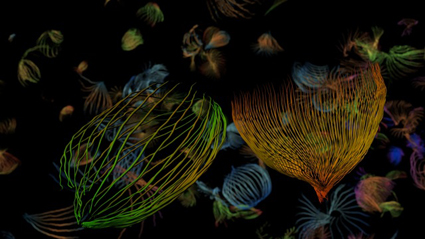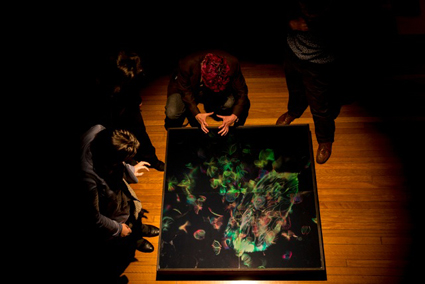Palpable virtualities
Keith Gallasch, Paula Dawson, Holoshop: Drawing and Perceiving in Depth

Paula Dawson, Hyperobject, My Homeland (detail), 2013, production still for holographic digital print
courtesy the artist
Paula Dawson, Hyperobject, My Homeland (detail), 2013, production still for holographic digital print
I’m staring down into the dark depths of a pool in which unrecognisable organic forms drift peacefully or their tendrils propel them past each other or into the bottomless dark. Actually, I’m look at the glass surface of a low, metre-square box on a gallery floor, but so convincing is the three-dimensional realisation of these luminescent life-like forms that I happily suspend disbelief, encouraged by the absence of the hard edges of 3D filmmaking.
I’m told by an art student invigilator that the tendrilled creatures are apparently constructed from 3D scans of the life-lines of human hands. More surprising is the news that the technology employed to realise this fantasia is adapted by hologram artist Paula Dawson from US military equipment designed to recognise and learn topography in war-torn Iraq and Afghanistan.

Paula Dawson, Hyperobject, My Homeland, 2013 installation, Holoshop exhibition
courtesy the artist
Paula Dawson, Hyperobject, My Homeland, 2013 installation, Holoshop exhibition
Creatures appearing in another screen, this one hanging from a wall, ease gently in and out of the frame, their delicacy and transparency belying a near palpable sense of solidity.
Nearby there’s an opportunity to play with a device emanating from an Australian Research Council funded project, with Dawson as one of its team of international investigators. It aims to “forge a set of innovative technologies and processes for creating realtime 3D digital content for holograms and other 3D display systems with virtual tools which enable the direct hand-drawing of subjects, mark by mark.” Manipulating the pen, which is held by flexible armature, feels distinctly odd when a 2D egg-shaped image on the screen ‘feels’ three-dimensional as I move the pen across it. This digitally generated tactility is an intriguing dimension of the Holoshop project.
This show, which includes Dawson’s helium-neon laser holograms, delights in its play with perception and its suggestion of the creative and other possibilities of the strangely named Holoshop. Yet again there is a sense of the uncanny in an ISEA2013 exhibition.






